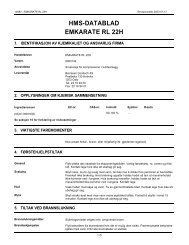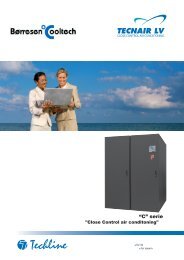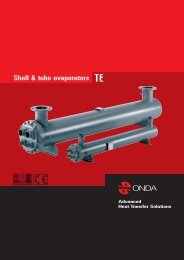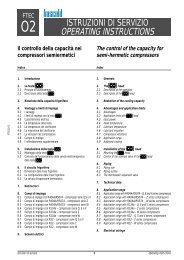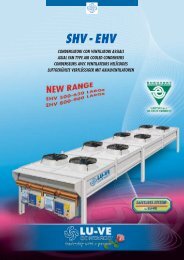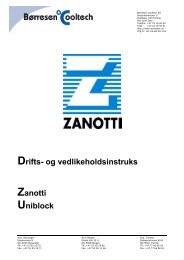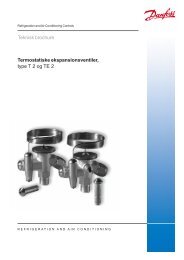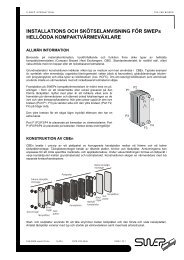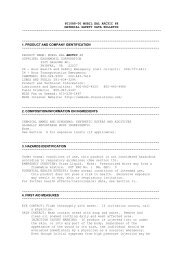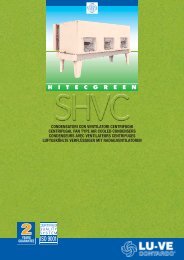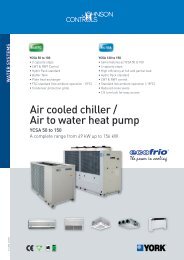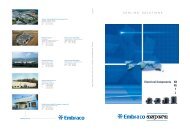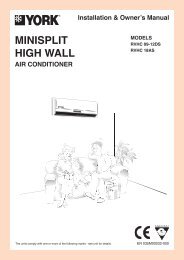Star Cold MC-line CONDENSING UNITS
Star Cold MC-line CONDENSING UNITS
Star Cold MC-line CONDENSING UNITS
You also want an ePaper? Increase the reach of your titles
YUMPU automatically turns print PDFs into web optimized ePapers that Google loves.
<strong>Star</strong> <strong>Cold</strong><strong>MC</strong>-<strong>line</strong><strong>CONDENSING</strong> <strong>UNITS</strong>INSTALLATION, OPERATION AND MAINTENANCEBE VERY CAREFUL WHEN YOU MEET THIS INDICATION ON THE LEFT SIDE
INSTALLATION, OPERATION AND MAINTENANCE<strong>MC</strong>001E1. GENERAL INFORMATION AND INTRODUCTION .............................................................................41.1. SYSTEM TECHNICAL DATASHEET............................................................................................42. PROCEDURES BY CLIENT ON DELIVERY........................................................................................42.1. CONDITION CHECK ....................................................................................................................42.2. UNLOADING AND HANDLING OPERATIONS ............................................................................42.2.1 SLINGING AND PRECAUTIONS ............................................................................................................... 42.2.2 POSITIONING.............................................................................................................................................. 53. LOCATION AND POSITIONING ..........................................................................................................53.1. BASE AND POSITIONING ...........................................................................................................53.1.1 OUTDOOR UNIT POSITIONING............................................................................................................... 53.1.2 ACCESSIBILITY ......................................................................................................................................... 53.1.3 CONDENSER COOLING AIR..................................................................................................................... 53.1.4 CONDENSER COOLING WATER............................................................................................................. 53.1.5 ELECTRICAL POWER SUPPLY LINE ....................................................................................................... 53.1.6 EARTHING.................................................................................................................................................. 63.2. POSITION OF EVAPORATOR <strong>UNITS</strong> AND THERMOSTAT BULB.............................................64. REFRIGERATION CONNECTIONS REQUIRE QUALIFIED PERSONNEL ........................................64.1. PIPELINES ...................................................................................................................................64.2. COLD PIPELINE INSULATION ....................................................................................................64.3. SEALING EFFICIENCY TESTING................................................................................................64.4. UNIT SEALING EFFICIENCY TEST.............................................................................................64.5. SYSTEM SEALING EFFICIENCY CHECK ...................................................................................75. ELECTRICAL CONNECTIONS AND HOOK-UP .................................................................................75.1. PRECAUTIONS AND CHECKS....................................................................................................75.1.1 POWER SUPPLY AND TOLERANCES ..................................................................................................... 75.2. ELECTRICAL DRAWING..............................................................................................................75.2.1 WIRE DIMENSIONS.................................................................................................................................. 75.2.2 ELECTRICAL CONNECTIONS BETWEEN THE <strong>CONDENSING</strong> UNIT AND AIR EVAPORATORS. ........ 75.2.3 REMOTE EVAPORATORS/CONDENSERS – SAFETY SWITCH.............................................................. 75.2.4 ELECTRICAL CONNECTIONS BETWEEN THE <strong>CONDENSING</strong> UNIT AND CONTROL PANEL. ............ 85.2.5 POSITION OF THERMOSTAT SENSOR.................................................................................................... 85.3. TESTS ..........................................................................................................................................85.3.1 PRELIMINARY VISUAL INSPECTIONS ................................................................................................... 86. REFRIGERANT CHARGING OPERATIONS REQUIRE QUALIFIED PERSONNEL ..........................86.1. REFRIGERANT TYPE AND LUBRICANT OIL .............................................................................86.2. VACUUMING THE UNIT........................................................................................................................... 86.3. REFRIGERANT CHARGING..................................................................................................................... 87. INSPECTION OF THE CONDENSER FANS REQUIRES QUALIFIED PERSONNEL. .......................97.1. CHECKING THE DIRECTION OF ROTATION.............................................................................97.2. ELIMINATION OF OBSTRUCTIONS TO AIR FLOW....................................................................98. CONTROL AND STATUS PANEL .......................................................................................................98.1. ACCESS PROCEDURE (only on enclosed units for outdoor installation).....................................98.2. PROTECTION CALIBRATION AND CHECKS .............................................................................98.3. ACCESS RESTRICTION..............................................................................................................98.4. SETTABLE PROTECTIONS.........................................................................................................98.5. FUSE REPLACEMENT...............................................................................................................109. AUTOMATIC FUNCTIONALITIES .....................................................................................................109.1. COLD ROOM TEMPERATURE CONTROL ...............................................................................109.2. DEFROST MANAGEMENT ........................................................................................................109.3. CONDENSATION PRESSURE CONTROL ................................................................................109.4. MOP ELEMENT IN THERMOSTATIC VALVES .........................................................................109.5. PUMP DOWN MODE OPERATION............................................................................................109.6. OIL TEMPERATURE CONTROL IN SYSTEMS WITH SCREW COMPRESSORS ...................1010. PROTECTIONS ..............................................................................................................................1010.1. PRESSURE OVERLOAD IN COOLING CIRCUIT..................................................................1010.2. REFRIGERANT PRESSURE DEFECT ..................................................................................1110.3. INSUFFICIENT COMPRESSOR LUBRICATION....................................................................1110.4. INSUFFICIENT OIL LEVEL IN COMPRESSOR .....................................................................1110.5. COMPRESSOR MOTOR TEMPERATURE OVERLOAD thermal cutout module...................1110.6. CONDENSER FAN MOTOR TEMPERATURE OVERLOAD..................................................1110.7. AIR EVAPORATOR FAN MOTOR TEMPERATURE OVERLOAD.........................................1110.8. INCORRECT PHASE SEQUENCE.........................................................................................1111. SIGNALS ........................................................................................................................................1211.1. LIQUID TRANSFER SIGHT GAUGE......................................................................................1211.2. HUMIDITY INDICATOR ..........................................................................................................1211.3. OIL LEVEL SIGHT GAUGE ....................................................................................................1211.4. REFRIGERANT PRESSURE GAUGES .................................................................................122 / 18
INSTALLATION, OPERATION AND MAINTENANCE<strong>MC</strong>001E12. SYSTEM START-UP IN PRESENCE OF QUALIFIED PERSONNEL............................................1212.1. PRELIMINARY CHECKS........................................................................................................1212.1.1 CASING PREHEATING............................................................................................................................ 1212.1.2 PRECAUTIONS ........................................................................................................................................ 1212.1.3 CHECKING THE DIRECTION OF COMPRESSOR ROTATION ............................................................. 1312.1.4 CHECKING THE DIRECTION OF FAN ROTATION ................................................................................ 1312.1.5 PANEL CLOSURE CHECK ...................................................................................................................... 1312.1.6 REFRIGERANT CHARGE CHECK .......................................................................................................... 1312.1.7 LUBRICANT OIL RETURN CHECK ......................................................................................................... 1312.1.8 THERMOSTATIC VALVE CALIBRATION CHECK .................................................................................. 1312.1.9 FILTRATION ON SUCTION ON INITIAL START-UP............................................................................... 1313. PRECAUTIONS IN THE EVENT OF PROLONGED DISUSE ........................................................1413.1. CLOSURE OF REFRIGERANT VALVES ...............................................................................1413.2. RE-START AFTER PROLONGED SHUTDOWNS .................................................................1413.2.1 ADVANCE POWER-UP............................................................................................................................ 1413.2.2 CHECKS AND PRECAUTIONS................................................................................................................ 1414. PERIODIC MAINTENANCE BY QUALIFIED PERSONNEL..........................................................1414.1. PRECAUTIONS ......................................................................................................................1414.2. MONTHLY MAINTENANCE (OR EVERY 200 HOURS).........................................................1414.2.1 SAFETY DEVICE AND CONTROL CHECK............................................................................................. 1414.2.2 ELECTRIC TERMINAL TIGHTENING CHECK ........................................................................................ 1414.2.3 ELECTRIC CONTACT CONDITION CHECK ........................................................................................... 1414.2.4 REFRIGERANT AND OIL LEAK CHECK ................................................................................................. 1414.2.5 CASING HEATER CHECK ....................................................................................................................... 1514.2.6 EARTHING EFFICIENCY CHECK ........................................................................................................... 1514.2.7 CONDENSER CLEANING........................................................................................................................ 1514.2.8 MECHANICAL FILTERS ON INTAKE (when fitted) ................................................................................. 1514.3. QUARTERLY MAINTENANCE (OR EVERY 800 HOURS) ....................................................1514.3.1 REFRIGERANT HUMIDITY CHECK ........................................................................................................ 1514.3.2 DRIER FILTER CARTRIDGE REPLACEMENT ....................................................................................... 1514.3.3 COMPRESSOR NOISE – VIBRATION CHECK....................................................................................... 1515. PROTECTING THE ENVIRONMENT – MAINTENANCE - SCRAPPING ......................................1615.1. REPAIRS TO REFRIGERATION CIRCUITS BY QUALIFIED PERSONNEL .........................1615.2. SCRAPPING SYSTEM <strong>UNITS</strong>................................................................................................1616. TROUBLESHOOTING....................................................................................................................173 / 18
INSTALLATION, OPERATION AND MAINTENANCE<strong>MC</strong>001E1. GENERAL INFORMATION AND INTRODUCTIONThis manual regards the systems designed for cooling, conserving and freezing at medium, low and very lowtemperatures, with single and multiple circuits, identified with the symbols:SP-UM-UMAU<strong>MC</strong>- U<strong>MC</strong>A<strong>MC</strong> – <strong>MC</strong>C -<strong>MC</strong>IThe interconnections of the cooling and electrical circuits must be made on site by qualified personnel, whomust also ensure correct charging of refrigerant and strict observance of all professional and safetystandards (directive 97/23/CE).The presence of pressurised and electrical equipment require specific qualifications of the personnelassigned for these tasks.As a general rule, all operations on the machine during installation and maintenance must only be performedafter disconnecting the electrical power supply.1.1. SYSTEM TECHNICAL DATASHEETThis applies to each individual serial number.It is an integral part of this document and specifies: The cooling circuit layout The description of the components installed Specifications of the electrical power supply Type and dimensions of equipment Setting sheetThe units are supplied with dry cooling circuitry and nitrogen pressurisation.2. PROCEDURES BY CLIENT ON DELIVERYOn delivery of the equipment, the client should perform a thorough check of all contents.2.1. CONDITION CHECKThe equipment leaves the supplier’s factory after precise testing and in perfect condition. Therefore, if anydamage is detected on delivery, this will have been caused during transport and must be reported to theshipping agent and noted on the delivery documentation prior to acceptance.The supplier or representative in the EU must be notified immediately in detail of the entity of any damage.2.2. UNLOADING AND HANDLING OPERATIONSThese operations require adequate equipment based on the dimensions and weight of the equipment to bemoved.Take great care to avoid sudden or violent movements.Avoid using machine components as points of leverage.Use suitable tools to unpack the equipment and avoid damage to the surface.2.2.1 SLINGING AND PRECAUTIONSThe units are equipped with attachment points, clearly indicated by means of yellow labels in the form ofarrows. If the unit is packed with wooden lateral supports, these should be removed prior to installation.The equipment can be lifted by means of a lift truck or a crane of adequate capacity.Slinging must not generate transversal stress on the machine structure, which must also be protected fromfriction with any lifting ropes used.All relative precautions must be observed, including the constant use of anti-release devices, correctbalancing of the lift truck, load capacity limits and all other applicable safety standards.If rollers are used for short transits, the relative distance between rollers must never exceed one metre.Never upturn or inc<strong>line</strong> machine parts.For SP/UM/UMA/<strong>MC</strong>/<strong>MC</strong>I units: the remote control panel, featuring compact dimensions and weight, is notdifficult to handle; and is normally located inside the condensing unit, easily removed after detaching one ofthe side panels. It should be removed from its packagingonly at the time of installation.4 / 18
INSTALLATION, OPERATION AND MAINTENANCE<strong>MC</strong>001E2.2.2 POSITIONINGWhen possible, transfer the equipment directly from the transport means to the relative base, which must beflat and stable; if this is not possible, equipment must always be placed on horizontal, stable and evensurfaces.3. LOCATION AND POSITIONINGThe following is envisaged:• for outdoor units, installation outdoors without protections or sheltered, provided that there are noobstructions to the complete and efficient removal of hot cooling air from the condenser (as specified inthe appendix).• for machinery room units, ensure adequate clearances for maintenance and suitable room ventilation.3.1. BASE AND POSITIONINGThe base must be stable, able to withstand the weight of the unit, perfectly horizontal over the machinegroundcontact zone and protected against the build-up of water.Suitable rubber anti-vibration mounts or a neoprene rubber strip should be inserted between the machineand the base.3.1.1 OUTDOOR UNIT POSITIONINGSee drawing/specifications.These units must have sufficient perimeter clearances to enable maintenance and adequate space forcirculation of air around the condenser coil.The minimum distance for air intake should be 0.8 m for single coils and 1.2 m for double or inc<strong>line</strong>d coils.During installation, personnel should also ensure free air circulation without obstacles both on intake anddelivery.3.1.2 ACCESSIBILITYTo enable inspections, maintenance and repairs, the condensing units must be accessible from all sides.3.1.3 CONDENSER COOLING AIROn standard versions, and therefore in most cases, the condensing unit envisages forced air cooling ofcondensers, with orthogonal flow, i.e. with horizontal intake and vertical delivery.No obstacle must impair free flow circulation, therefore:• intake ports must be completely free• filters protecting the ports must be cleaned periodically, as specified in the chapter on maintenance andin any event when clogged, for example during springtime when the air is filled with fluff from poplartrees.• the upper space must remain totally free, also from hanging tree branches.3.1.4 CONDENSER COOLING WATERAll suitable precautions must be taken and adequate supervision must be ensured to eliminate the risk ofwater freezing in the equipment. If the equipment is subject to prolonged disuse, the relative circuits must beemptied completely.If this is not carried out, serious damage could be caused, also due to water entering the cooling circuit.It is strongly recommended to install an adequate filter on the water inlet to the condenser.3.1.5 ELECTRICAL POWER SUPPLY LINEThe system electrical <strong>line</strong>, with input on the electrical panel terminal board located in the unit or on the maindisconnector switch, must be suitably sized on the basis of maximum current absorption.The selection of materials, sizing, installation procedures and testing must comply with national standards.The power <strong>line</strong> must be suitably protected according to current standards.5 / 18
INSTALLATION, OPERATION AND MAINTENANCE<strong>MC</strong>001E3.1.6 EARTHINGThe installation must be connected to the earthing <strong>line</strong>, using the terminal supplied by the manufacturer,before the initial power-up of the equipment during installation.Connections, installation of the earthing <strong>line</strong>, total efficiency of the latter and compliance with currentstandards throughout use is the responsibility of the user.3.2. POSITION OF EVAPORATOR <strong>UNITS</strong> AND THERMOSTAT BULBRefer to the relative operation and maintenance manual.4. REFRIGERATION CONNECTIONS REQUIRE QUALIFIED PERSONNELTHE <strong>UNITS</strong> ARE ASSEMBLED/CONSTRUCTED IN COMPLIANCE WITH PED DIRECTIVE 97/23/EC. ALLCONNECTIONS ON THE SYSTEM MUST BE MADE BY QUALIFIED PERSONNEL AND CERTIFIED INOBSERVANCE OF THE ABOVE STANDARDS.IT IS THE CLIENT’S RESPONSIBILITY TO EQUIP THE ASSEMBLED CIRCUIT WITH SUITABLE SAFETYDEVICES IN ACCORDANCE WITH DIRECTIVE 97/23/EC. IT IS ALSO THE CLIENT’S RESPONSIBILITYTO DRAW UP THE INSTALLATION DESIGN AND COLLECT CERTIFICATION OF ALL ASSEMBLEDCOMPONENTS AS WELL AS THAT OF THE CIRCUIT WELDERS FOR SUBSEQUENT REGISTRATIONAT THE COMPETENT OFFICES.THESE INSTRUCTIONS ARE INTENDED AS A REFERENCE TO PROFESSIONAL STANDARDS TOENSURE INTEGRITY OF THE <strong>CONDENSING</strong> UNIT, WHICH COULD BE DAMAGED BY INCORRECTCONNECTIONS.• Circuit leaks are not admitted. The refrigerant is a pollutant and a reduction in charge may impair thermodynamicperformance of the system thus increasing electrical power consumption.• the routing of pipe<strong>line</strong>s and relative sizing must ensure correct operation and circulation of the lubricantoil of the compressors.• impurities must not be present in the circuit as these may obstruct correct operation of the thermostaticvalves and damage the compressor.• the circuit must not be subject to humidity as this alters the characteristics of the lubricant oil with the riskof damage to the compressor motor windings and may block operation of the thermostatic valves.• no air must be present in the circuit as this constitutes a hazard and can cause malfunctions or damageof the compressor.• On systems with remote condensation a check valve should be installed on the discharge <strong>line</strong> in thevicinity of the unit.4.1. PIPELINESALL PIPELINES, BENDS AND UNIONS MUST BE CERTIFIED ACCORDING TO THE DIRECTIVE97/23/EC AND COMPLY WITH NATIONAL STANDARDS.ALL WELDINGS MUST BE PERFORMED BY QUALIFIED PERSONNEL AND CERTIFIED ACCORDINGTO THE PED DIRECTIVE 97/23/EC AND COMPLY WITH NATIONAL STANDARDS.Connection pipe<strong>line</strong>s must, in principle, be as short as possible, both to reduce pressure drops and therebymaintain system performance, and to reduce to overall volume occupied by the refrigerant; therefore thequantity of the latter remains proportional to the volume.4.2. COLD PIPELINE INSULATIONThe pipe<strong>line</strong>s, in particular the cool intake <strong>line</strong>s, must be efficiently insulated.This prevents dispersion and condensation of humidity with consequent oxidation and dripping.4.3. SEALING EFFICIENCY TESTINGIn a cooling system, sealing of the unit is absolutely essential.Sealing testing is therefore a fundamental phase in installation and as such must be carried out with greatcare.4.4. UNIT SEALING EFFICIENCY TESTThe unit is delivered immediately after a sealing test in nitrogen pressure conditions.6 / 18
INSTALLATION, OPERATION AND MAINTENANCE<strong>MC</strong>001ETherefore, before joining operations, the pressure must be discharged from the machine, paying attention tothe fact that this machine is pressurised.If the machine is already discharged, the following may be required:1. locate the leakage2. repair3. pressurise the circuit with nitrogen4. seal the circuit after inserting a control pressure gauge5. verify that in the subsequent 12 hours the pressure reading on the gauge does not fallThe operation of joining the unit and utilities must only be performed after setting up all connection <strong>line</strong>s fromthe utilities to the machine.4.5. SYSTEM SEALING EFFICIENCY CHECKRefer to installation design according to current EC standards.5. ELECTRICAL CONNECTIONS AND HOOK-UPELECTRICAL CONNECTIONS ARE THE TASK AND RESPONSIBILITY OF THE USER. THESEINSTRUCTIONS ARE INTENDED AS A REFERENCE TO PROFESSIONAL STANDARDS TO ENSUREINTEGRITY OF THE CONTROL UNIT, WHICH COULD BE DAMAGED BY INCORRECT CONNECTIONS.The unit and relative electrical accessories comply with the low voltage directive 73/23/EC. Make allelectrical connections to the unit according to indications in the electrical wiring diagram enclosed. Take careto observe the safety standards EN 60204, EN 60335 and all national standards.The selection of materials, sizing, installation procedures and testing must comply with current nationalstandards.5.1. PRECAUTIONS AND CHECKSBefore proceeding with any installation or maintenance operation on the electrical system, the operator mustensure that the system is disconnected from the power supply and that the latter cannot be switched oninadvertently during the operations required.5.1.1 POWER SUPPLY AND TOLERANCESFirst of all ensure that parameters available for power supply: number of phases, voltage and frequency,correspond to those specified on the dataplate on board the machine.The power supply voltage must never be subject to variations exceeding ±5% with respect to the nominalvalues. Unbalance between the phases must never exceed 5%.5.2. ELECTRICAL DRAWING5.2.1 WIRE DIMENSIONSThe section of the wires must be suited to the current conveyed and the distances to be covered (themaximum current absorption values are stated on the electrical wiring diagram enclosed).Check absorption values on the plates affixed to each utility.5.2.2 ELECTRICAL CONNECTIONS BETWEEN THE <strong>CONDENSING</strong> UNIT AND AIR EVAPORATORS.These connections, to be made according to the wiring diagram enclosed, mainly concern:• fan unit, defrost sensor, air evaporator thermal overload protections, defrost resistances,power interlock5.2.3 REMOTE EVAPORATORS/CONDENSERS – SAFETY SWITCHThe UMA/UM/SP/<strong>MC</strong>/<strong>MC</strong>I units are designed with direct power supply to the evaporators.All maintenance operations require compulsory disconnection of the machine electric power supply; beforeproceeding with work affix a notice stating “maintenance in progress” on the machine.The machine power must be shut off when the machine is stationary.If required, an emergency switch can be fitted and connected between the terminals of the external interlock,marked with the symbol “IE”, on the terminal board of the panel on board the machine, which when activatedshuts off the auxiliary power supply circuit and stops the machine.7 / 18
INSTALLATION, OPERATION AND MAINTENANCE<strong>MC</strong>001E5.2.4 ELECTRICAL CONNECTIONS BETWEEN THE <strong>CONDENSING</strong> UNIT AND CONTROL PANEL.thermostat sensor, compressor control elements, defrost indicator lamp, start-stop indicator lamps5.2.5 POSITION OF THERMOSTAT SENSORThe position of the thermostat sensor must be chosen with care, avoiding impact with air in anomalousconditions such as air deriving from doors opened in a cold room, from compensation valves or other. Forfurther information refer to the evaporator operation and maintenance manual.5.3. TESTS5.3.1 PRELIMINARY VISUAL INSPECTIONSCEI EN 60204-1, visual inspection:1. Presence and identification of main terminal PE.2. Identification of all other terminals with graphic symbol of earth or coloured yellow/green.3. Exclusive purpose of terminals for equipotential bonding connections.4. Connection of one wire only to each terminal.5. Yellow/green colouring of possible insulation on protection wires.6. Absence of active wires with yellow/green insulation.7. Absence of tubes or ducts used as protection wire.8. Absence of fuses, circuit breakers or disconnect switches for equipotential bonding protection.9. Conformity of wire section to minimum values stated by standards.10. Check that electrical connections have been made correctly.In particular the connections of the phases, after opening the box containing the compressor terminal board,must be made according to instructions on the compressor electrical enclosure, according to the type ofcompressor – direct or part winding start-up – and the machine wiring diagram.6. REFRIGERANT CHARGING OPERATIONS REQUIRE QUALIFIED PERSONNELTHE REFRIGERANT CHARGING OPERATIONS, PARTIAL OR COMPLETE, ARE THE TASK ANDRESPONSIBILITY OF THE USER.THESE INSTRUCTIONS ARE INTENDED AS A REFERENCE TO PROFESSIONAL STANDARDS TOENSURE INTEGRITY OF THE CONTROL UNIT, WHICH COULD BE DAMAGED BY INCORRECTCHARGING.The procedure can be started after all refrigeration pipe<strong>line</strong>s have been laid and electrical connectionscompleted.6.1. REFRIGERANT TYPE AND LUBRICANT OILThe machine dataplate states the following both for the refrigerant and lubricant oil:• Product type6.2. VACUUMING THE UNITOpen all valves and solenoid valves on the circuit. Eliminate air from the entire system, including thecompressor on the intake side and high pressure side, using a vacuum pump. On completion of theoperation a permanent vacuum must be obtained of below 1.5 mbar.NEVER START UP THE COMPRESSOR IN VACUUM CONDITIONSNEVER POWER UP THE MACHINE EVEN FOR CHECKING PURPOSES6.3. REFRIGERANT CHARGINGOnly charge with the type of refrigerant stated on the machine dataplateBefore charging:‣ Activate the compressor casing resistance‣ Check the oil level in the compressors,‣ Do not start up the compressorCharge the liquid refrigerant directly in the liquid receiver.6.4. CHARGE CHECKThe charge level must be determined with precision, an excessively low or high quantity of refrigerant canimpair correct operation.8 / 18
INSTALLATION, OPERATION AND MAINTENANCE<strong>MC</strong>001EIMMEDIATELY AFTER CHARGING, CHECK SYSTEM SEALING EFFICIENCY, TESTING ALLCOUPLINGS WITH A DETECTOR ABLE TO READ MINIMAL REFRIGERANT LEAKS.IN THE RARE CASE THAT A LEAK IS DETECTED, DO NOT PROCEED WITH REPAIRS BY WELDINGUNTIL A REFRIGERATION TECHNICIAN HAS BEEN CALLED AND THE RELATIVE SECTION HASBEEN CLEANED THOROUGHLY TO REMOVE ALL TRACES OF OIL. BURNT RESIDUE FROMWELDING TEMPERATURES WILL IMPAIR SYSTEM FUNCTIONALITY AND RELIABILITY.CAUTION: IF INSULATION IS MADE OF OLD PRODUCTION POLYURETHANE FOAM, THE DETECTORMAY READ THE PRESENCE OF GASES SIMILAR TO REFRIGERANT GASES USED FOR THEPRODUCTION OF THIS TYPE OF FOAM. IN THE EVENT OF ANY DOUBT, REMOVE PART OF THEINSULATION TEMPORARILY. THE PIPELINE INSULATION SHOULD ONLY BE COMPLETED AFTERTHE LAST CHECK.7. INSPECTION OF THE CONDENSER FANS REQUIRES QUALIFIED PERSONNEL.Installation must take into account the compulsory clearances required for optimal circulation of air.Each fan has the blade protected against hazardous accidental contact; these guards must never beremoved or tampered with.7.1. CHECKING THE DIRECTION OF ROTATIONThe fans reach the specified flow rate by rotating in a specific direction as indicated on the unit.Check and, if necessary, invert the phases to ensure the correct direction of rotation.7.2. ELIMINATION OF OBSTRUCTIONS TO AIR FLOWThe air flow must never be obstructed.Refer to the specifications.Cooling air must never be contaminated; avoid intake from pollutant industrial facilities or from manureyards/slurry or intensive cattle breeding centres, sources of ammonia pollutants.The condenser coils are protected by metal filters which may clog; keep the front of the intake zone clean atall times.8. CONTROL AND STATUS PANEL8.1. ACCESS PROCEDURE (only on enclosed units for outdoor installation)To access the control status panel, remove the snap-fit protection panel by lifting and pulling outwards asshown, to detach it from the main panel.The panel must always be refitted with care after inspection.8.2. PROTECTION CALIBRATION AND CHECKSFor these types of operation, to be performed by qualified personnel, access to the electrical panel interior isrequired.8.3. ACCESS RESTRICTIONBefore opening the hinged panel, by means of the specific key for access to the interior, the system powermust be shut off by turning the disconnect switch lever located on the door of the electrical panel fromposition 1 to 0, and taking suitable precautions to avoid inadvertent activation.The machine power must be shut off when the machine is stationary.8.4. SETTABLE PROTECTIONSAccess to the interior of the panel also enables access to the protections for relative calibration procedures.The calibration value is established and set during equipment testing prior to delivery; any modification tothese values must be made by qualified personnel and after verifying the specific purpose.Lower values may cause an unjustifiable shutdown of the utility concerned while excessive values maycause burnout due to the lack of protection.9 / 18
INSTALLATION, OPERATION AND MAINTENANCE<strong>MC</strong>001E8.5. FUSE REPLACEMENTThis operation also requires access to the interior of the panel.A blown fuse indicates a serious malfunction of connections or utility, or may be caused by an externalsource, at times due to atmospheric discharges.Before replacement, identify the cause of the fault and remedy.Always replace fuses of with versions of the same type and capacity.9. AUTOMATIC FUNCTIONALITIESThese are the units that enable automatic system operation.9.1. COLD ROOM TEMPERATURE CONTROLThe control of the cold room temperature is by means of the thermostat installed on the control panel. Thisinstrument – refer to the specific instructions enclosed – is normally electronic.9.2. DEFROST MANAGEMENTRefer to the specific instructions for the instrument and evaporator.9.3. CONDENSATION PRESSURE CONTROLEnsure the correct type of condensation control with reference to the electrical wiring diagram.Maintain the condensation pressure set points specified in appendix . The machine is designed to operate inthese specific conditions.In the case of water type condensers, install a pressure switch valve for condensation control.9.4. MOP ELEMENT IN THERMOSTATIC VALVESAlways use thermostatic valves with MOP (Max operating pressure) elements.9.5. PUMP DOWN MODE OPERATIONIf this solution is adopted in systems with piston or screw compressors, ensure that the pressure switch tripthreshold for shutdown in Pump-down mode is at least 0.5 bar above the low pressure safety pressureswitch threshold.If using scroll compressors, shutdown in pump-down mode is prohibited.9.6. OIL TEMPERATURE CONTROL IN SYSTEMS WITH SCREW COMPRESSORSIn systems with semi-hermetic screw compressors used at low temperatures, ensure that the oil temperatureis maintained within a suitable range. For this purpose an air oil cooler with finned coil or water type heatexchanger is installed to prevent the oil from reaching high temperatures, and a thermostat-controlledelectric heater is inserted in the oil separator, fitted with an electro-mechanical control thermostat to limittemperature reductions. The control of the air oil cooler is by means of a multi-step thermostat whichactivates and deactivates the fans, varying the air flow rate and consequently heat exchange. In the case ofwater type exchangers, the oil temperature is maintained constant by a pressure controlled valve which actson the water flow rate.In both cases refer to the documentation enclosed and the wiring diagram for further details.10. PROTECTIONSThe system is equipped with protections to safeguard against anomalous situations, acting both on thepressurised circuit and the power circuit.It is the client’s responsibility to equip the assembled circuit with suitable safety devices in accordance withdirective 97/23/EC and relative national standards.10.1. PRESSURE OVERLOAD IN COOLING CIRCUITProtection against excessive pressure of refrigerant in the delivery <strong>line</strong>, which can impair systemfunctionality and constitutes a hazard to personnel, features two activation stages.- when pressure reaches values over 25 bar, the maximum pressure switch trips, according to factorysettings, to cause system shutdown. Operation can be restored manually, only after eliminating the cause ofthe problem.- if the maximum pressure switch does not trip, the safety valve is activated. Activation of this device, legallycompulsory on all pressure equipment, causes the partial or total exit and loss of the refrigerant charged inthe system and must be considered an exceptional event.10 / 18
INSTALLATION, OPERATION AND MAINTENANCE<strong>MC</strong>001E10.2. REFRIGERANT PRESSURE DEFECTIf pressure falls to below factory settings, the minimum pressure switch trips.This shuts down the compressor motor, but not permanently. If the intake pressure returns to normal values,the equipment re-enables start-up. This is acceptable if it concerns a transitory occurrence, but if repeatedrequires specific maintenance.10.3. INSUFFICIENT COMPRESSOR LUBRICATIONThe oil pressure switch is fitted on all systems with compressors that have pump-operated lubrication (insidecompressor). Activation is delayed by a 120” interval to filter pressure transients on compressor start-up.Reset is manual by means of the pushbutton on the front panel of the pressure switch, when possible to beperformed after around 15’.Obviously the oil level must be checked immediately.If the pressure switch requires replacement, use one of the same brand and type, or request information onother admissible models from the manufacturer.In systems with semi-hermetic screw compressors, safety of the oil return <strong>line</strong> to the compressor, and thusadequate internal lubrication is ensured by a flow switch installed on the compressor oil return <strong>line</strong> from theseparator. The signal is sent to an electronic module and activation is delayed by a few seconds by meansof a timer to avoid flow stabilising transients after compressor re-start.10.4. INSUFFICIENT OIL LEVEL IN COMPRESSORIn systems with semi-hermetic screw compressors, a float is installed in the oil separator to indicate lowlevels and thus the need to replenish oil levels in the system. This signal is delayed by a few minutes toprevent fluctuations on system start-up from generating unjustified alarms.10.5. COMPRESSOR MOTOR TEMPERATURE OVERLOAD thermal cutout moduleOn systems with semi-hermetic, reciprocating, screw or medium output scroll compressors no lower than 7.5HP, thermal cutouts are electronic, based on thermistors inserted in each of the motor phase windings.These sensors are connected to an external electronic module, capable of reading resistance unbalance,and therefore temperature levels, and activating to shut off the main power supply.On systems with hermetic reciprocating and low output scroll compressors less than 7.5 HP,thermal cutouts are internal and interrupt continuity of the motor phase windings, shutting downthe machine without any external signal. For further information refer to the compressor operationand maintenance manual.10.6. CONDENSER FAN MOTOR TEMPERATURE OVERLOADOn all systems with 3-phase motor condenser fans, thermal protection of the motors is guaranteed bymeans of a thermal relay located down<strong>line</strong> of the power supply contactor of the corresponding motor.Activation of this device does not shut down the compressor and therefore the system, but only powersupply to the motor; it is the condensation pressure that on increase trips the maximum pressure switch andshuts down the compressor.Reset is manual by means of the pushbutton on the front panel of the relay inside the electrical panel.Indication of the fault is by means of a lamp on the door of the electrical panel or by means of the alarm anddefrost management instrument inside the same electrical panel on board the machine.10.7. AIR EVAPORATOR FAN MOTOR TEMPERATURE OVERLOADOn all systems with air evaporators fitted with single phase electric motors, thermal protection of the motorsis guaranteed by means of an internal relay which shuts down power supply to the single motor, withouthowever generating an external signal of the fault. When the winding temperature falls to admissible values,power supply is automatically restored.On systems where the air evaporators have 3-phase electric motors, the temperature overload is indicatedby means of an internal thermal relay, known as klixon. Normally, for air coolers with multiple fans, a seriesof all klixons is implemented and indicated on the unit electrical panel. In this way the alarm of a single fanshuts down the compressor. Reset is automatic and occurs only after the winding temperature has fallen toadmissible values (unless an interlock is envisaged on the machine control electronic instrument).Indication of the fault is by means of a lamp on the door of the electrical panel or by means of the alarm anddefrost management instrument inside the same electrical panel on board the machine.10.8. INCORRECT PHASE SEQUENCE11 / 18
INSTALLATION, OPERATION AND MAINTENANCE<strong>MC</strong>001EControl of the electrical phase sequence is important to guarantee correct rotation of the motor in screw andscroll compressors.In the first case, the correct sequence is guaranteed by an electronic controller named INT389 which alsochecks for phase failure, winding temperature overload alarms and compressor start-up delays. Activation ofthis device shuts off power supply to the compressor.In the second case a simpler electronic controller is installed, which, in the case of incorrect phasesequence, shuts off power supply of the entire auxiliary circuit and therefore the compressor.11. SIGNALSAs well as the luminous indicators and instruments installed on the panel of the electrical panel, identifiableon the electrical wiring diagram and documentation enclosed, the circuit envisages visual indicator lamps,the access to which, in the case of outdoor installations, may require removal of one or more metal panelsenclosing the structure of the condensing unit.These panels are snap-fit and must be lifted and pulled outwards to remove. Fixing screws may need to beloosened prior to removal.Always refit these panels with care as they convey the cooling air of the condensers.11.1. LIQUID TRANSFER SIGHT GAUGEThis is a transparent gauge installed on the liquid <strong>line</strong> and enables visual inspection of the charge status. Atfull operating speed, the flow must be continuous without foam or gas bubbles.If significant turbulence with the presence of gas is noted, take care to wait a few minutes before correctingthe charge level. This may be a transitory event caused by rapid opening of a thermostatic valve.11.2. HUMIDITY INDICATORThe level gauge also has a coloured element that indicates whether the refrigerant is dry or containshumidity.On the basis of the gauge indications, if humidity is present, replace the drier cartridges, drain and rechargethe machine.11.3. OIL LEVEL SIGHT GAUGEThe compressor casing is fitted with an oil level gauge which also indicates minimum and maximumadmissible level limits. If replenishment is required, also use exclusively the oil type stated on the machinedataplate and in the documentation.The oil level must be checked immediately after compressor start-up and at regular intervals during operation.11.4. REFRIGERANT PRESSURE GAUGESPressure gauges are installed on the unit to check pressure on various parts of the circuit.hermetic and semi-hermetic compressors without oil pump: pressure gauge on high pressure and lowpressure sides.• semi-hermetic compressors: pressure gauge on high pressure and low pressure sides and on the oilpump.12. SYSTEM START-UP IN PRESENCE OF QUALIFIED PERSONNELInitial system start-up requires observance and attention to a number of procedures.12.1. PRELIMINARY CHECKSThese checks must be performed on system start-up before reaching operating speed.12.1.1 CASING PREHEATINGActivate the compressor casing resistanceThe casing oil temperature before start-up must be around 15-20 °C higher than the ambient temperature orthe saturation temperature on the intake side.Units designed for outdoor installation, in environments with very low minimum ambient temperatures mayalso be equipped with electrical resistances, which have the same function as the casing resistances, alsoon the intake manifold and the oil reserve tank.12.1.2 PRECAUTIONS• Check once again to ensure correct installation of the cooling and electrical circuits, ensuring inparticular correct earthing of the equipment.• Ensure that all valves on the cooling circuit are open, and that bypass valves to the outside are closed12 / 18
INSTALLATION, OPERATION AND MAINTENANCE<strong>MC</strong>001Eand fitted with caps.• Ensure that the voltage on the terminals between the phases and neutral is as specified.• For part-winding motors: strictly observe the order of the part-windings indicated on the electrical wiringdiagram enclosed. The delay in connection of the second part-winding must be 0.5 s (max. 1 s).• Check the values of the timed relays.• Check the oil level in the compressors (in the sector marked in the level gauge)• Check that the control and safety device settings comply with the calibration table values enclosed andnational standards.12.1.3 CHECKING THE DIRECTION OF COMPRESSOR ROTATIONThe direction of reciprocating compressor can be either one; while the correct direction of screw and scrollcompressor rotation must be checked.For systems with these compressors, before starting up the unit:• Connect a pressure gauge to the intake valve coupling• Close the intake valve fully and then open by one turn• On semi-hermetic screw compressors: close the solenoid valve on the oil injection <strong>line</strong> (remove the coil).• <strong>Star</strong>t up the compressor briefly (0.5 – 1 sec)• Correct rotation: pressure of the gauge on intake lowers immediatelyIncorrect rotation: pressure of the gauge on intake increases and the electronic protection module trips.In this case invert the two phases on the terminal board.On semi-hermetic screw compressors: after checking, re-connect the solenoid coil of the oil injection <strong>line</strong>12.1.4 CHECKING THE DIRECTION OF FAN ROTATIONCheck the direction of fan rotation with 3-phase motors installed, according t the unit model, on:• air evaporators• condenser• head sections for compressor cooling• finned oil cooling coils• other special equipment with 3-phase fansTo check, ensure that the direction of the air flow guarantees correct operation of the equipment. Otherwise,invert two of the three power supply wires up<strong>line</strong> of the relative contactor, taking care that the direction ofrotation of other system motors is not altered.12.1.5 PANEL CLOSURE CHECKEnsure that the panels of the condensing unit structure are positioned correctly and closed to avoiddifficulties in the correct use of the condenser cooling air.12.1.6 REFRIGERANT CHARGE CHECKOn reaching operating speed, ensure the correct flow of refrigerant via the relative sight gauge on the liquid<strong>line</strong>.12.1.7 LUBRICANT OIL RETURN CHECKCheck compressor lubrication immediately after start-up.‣ Oil level from ¼ to ¾ of the sight gauge (repeated checks are recommended during the initial hours ofoperation).‣ On systems with oil pumps, check that the differential pressure of the pump (indicated on the oilpressure gauge) is between 1.4 and 3.5 bar.During the start-up phase, some foam may form on the oil, which should be minimised on reaching stableoperating conditions. If this does not occur, this may indicate a high concentration of liquid in the intake gas.12.1.8 THERMOSTATIC VALVE CALIBRATION CHECKSee instructions in the specific documentation.12.1.9 FILTRATION ON SUCTION ON INITIAL START-UPThe units with semi-hermetic screw compressors (or units to client specs) are equipped with containers formechanical filters on the intake <strong>line</strong>.Before starting up the system for the first time, a mesh cartridge should be inserted, which should bechecked after around four hours of operation, cleaning if necessary and repeating this check periodicallyuntil it can be guaranteed that all impurities have been removed.13 / 18
INSTALLATION, OPERATION AND MAINTENANCE<strong>MC</strong>001EAt this point the container without cartridge should be closed, to eliminate any cause of pressure drops.13. PRECAUTIONS IN THE EVENT OF PROLONGED DISUSEDecommissioning for prolonged disuse requires a number of precautions.13.1. CLOSURE OF REFRIGERANT VALVESIn the event of prolonged shutdown, the following operations are recommended:• close the valve down<strong>line</strong> of the liquid receiver;• After restricting most of the refrigerant charge to the high pressure side, close the compressor deliveryvalve;during the re-start phase, ensure that all valves are completely open13.2. RE-START AFTER PROLONGED SHUTDOWNSThis operation requires observance of a specific procedure and a number of precautions.13.2.1 ADVANCE POWER-UPThis preliminary operation is important together with the casing preheating procedure.13.2.2 CHECKS AND PRECAUTIONSThe procedure regarding system start-up must be repeated, observing all relative precautions.14. PERIODIC MAINTENANCE BY QUALIFIED PERSONNELCheck the system regularly according to national regulations.The following section provides general instructions regarding periodic maintenance required for units anddivided according to the specific frequency required.The end of this chapter provides specifications regarding maintenance operations recommended accordingto the type of compressor installed.In any event refer to the specific component operation and maintenance manual for further information andprocedures.14.1. PRECAUTIONSAll maintenance operations must be performed by, or under the direct supervision and responsibility ofqualified personnel.The system must be completely stationary and disconnected from the power supply before any operation.Disconnect the power supply only when the system is already stopped by means the automatic controldevices.14.2. MONTHLY MAINTENANCE (OR EVERY 200 HOURS)These operations are required on the units every month or every 200 hours of operation.14.2.1 SAFETY DEVICE AND CONTROL CHECKCheck operation of all control and safety devices such as pressure switches, safety valves electronic systemmanagement instruments.14.2.2 ELECTRIC TERMINAL TIGHTENING CHECKCheck tightening of all electric terminals both inside the electrical panels and on the terminal boards of allutilities.Take care also to check tightening of all fuses.14.2.3 ELECTRIC CONTACT CONDITION CHECKClean fixed and mobile contacts of all contactors, replacing in the event of wear or damage.14.2.4 REFRIGERANT AND OIL LEAK CHECKVisually check the entire cooling circuit, also inside the machines, to locate possible leaks of refrigerant,which are also indicated by traces of lubricant oil.Act immediately and investigate if in doubt.14 / 18
INSTALLATION, OPERATION AND MAINTENANCE<strong>MC</strong>001EAlso ensure the regular flow of refrigerant via the sight gauge on the liquid <strong>line</strong>. This operation should beperformed with care as the system must remain in operation.14.2.5 CASING HEATER CHECKCheck efficiency of the casing heater.If necessary, measure continuity by means of a suitable instrument.14.2.6 EARTHING EFFICIENCY CHECKCheck the earthing terminal and ensure efficiency by means of a suitable instrument.14.2.7 CONDENSER CLEANINGCleaning must be by means of compressed air on the internal side, with the jet in the opposite direction tothat of air intake. Repeat the same operation also for the condenser finned coil, taking care due to thecutting hazard present in this area.To clean filters (if required) and remove all adherent or oily particles, use a pressurised water jet, alsodetergents provided that these are neutral pH. Dry by means of compressed air.Refit filters with care before restarting the system.In some periods, often in springtime, cleaning may need to be more frequent due to the presence of vegetalimpurities in the air. A clogged filter is indicated by an increase in condensation pressure.14.2.8 MECHANICAL FILTERS ON INTAKE (when fitted)To fit or replace filters, proceed as follows:• close the inlet valve and valves on intake of the compressors.• discharge and collect the refrigerant trapped between valves.• proceed with replacement or cleaning as required.• close the filter container carefully, replacing the seal when possible;vacuum the machine14.3. QUARTERLY MAINTENANCE (OR EVERY 800 HOURS)These operations are required on the units every fourth month or every 800 hours of operation.14.3.1 REFRIGERANT HUMIDITY CHECKCarefully examine the colour of the sensitive humidity element in the sight gauge on the liquid <strong>line</strong>.Compare with the specifications table on the gauge instructions to determine possible presence of water. Allis correct if the reading is “dry”If humidity is detected, shut down the unit immediately and replace the drier cartridges, all refrigerant chargeand the oil present in the circuit.14.3.2 DRIER FILTER CARTRIDGE REPLACEMENTFor replacement, with the plant stationary, proceed as follows:• isolate the circuit section with the filter by closing the valves up and down<strong>line</strong> of the filter.• recover the gas in the isolated section• replace the cartridge• vacuum the isolated pipe<strong>line</strong> section• open the valves previously closed.DO NOT UNPACK THE CARTRIDGES UNTIL THE TIME OF INSTALLATION THIS GUARANTEESPERFECT CONSERVATION OF THE COMPONENT14.3.3 COMPRESSOR NOISE – VIBRATION CHECKCheck the entire system, in particular the pipe<strong>line</strong>s and capillary tubes to ensure there are no abnormalvibrations. If necessary, take suitable additional safety measures.The presence of strong vibrations may cause damage to the pipe<strong>line</strong>s and leakage of refrigerant and oil ontocomponents of the plant.15 / 18
INSTALLATION, OPERATION AND MAINTENANCE<strong>MC</strong>001E15. PROTECTING THE ENVIRONMENT – MAINTENANCE - SCRAPPINGRefrigerant fluids are subject to legal regulations that prohibit disposal into the environment, with compulsoryrecovery.Lubricant oils are also subject to similar regulations.Take into account the above when performing maintenance or scrapping refrigeration systems.15.1. REPAIRS TO REFRIGERATION CIRCUITS BY QUALIFIED PERSONNELALL PIPELINES, BENDS AND UNIONS MUST BE CERTIFIED ACCORDING TO THE DIRECTIVE97/23/EC AND COMPLY WITH NATIONAL STANDARDS. ALL WELDINGS MUST BE PERFORMED BYQUALIFIED PERSONNEL AND CERTIFIED ACCORDING TO THE PED DIRECTIVE 97/23/EC ANDCOMPLY WITH NATIONAL STANDARDS.In some cases and always when welding is required, the circuit must be emptied of refrigerant.If the refrigerant cannot be recovered, it must be returned to the retailer or suitable authorised wastedisposal firms.15.2. SCRAPPING SYSTEM <strong>UNITS</strong>When the system is to be scrapped, the following procedures are compulsory:1. total recovery of refrigerant fluid with adequate equipment and delivery to authorised personnel forrecovery and disposal.2. the same procedure applies to lubricant oil in the circuit, in particular that in the compressor casing andfilter cartridges impregnated in oil.separate the components into categories, such as iron and steel, copper and electrical wires, electric motorsand motor compressors, soundproofing panels in synthetic foam and heat insulation material. Theseparated materials must be delivered to suitable collection centres for recycling.16 / 18
INSTALLATION, OPERATION AND MAINTENANCE<strong>MC</strong>001E16. TROUBLESHOOTINGFault finding procedures and repairs must be performed by qualified personnel or may require intervention ofthe manufacturer.In the event of faults or malfunctions take care to observe the following section.Excessive confidence in procedures may cause damage to the environment or physical injury.All operations must be performed with the machine disconnected from the power supply.TROUBLESHOOTING TABLETROUBLE CAUSE SOLUTIONFilters are dirty.Condensing pressure too high.Air cooled condenserClean the filter and the condensersurface. Remove possible obstacles inorder to have a correct air flow.Condensing pressure too high.Water cooled condenserCondensing pressure too low.Air cooled condenserCondensing pressure is too lowWater cooled condensersCondensing pressure is notstable.1Fan or fan motor broken.Air flow direction not correctThe internal surface of the condenser isdirty.The water flow is not correct (too small)Low temperature of the ambient air.Too much air flow through the coils.Water temperature is too low.Too big quantity of water throughcondenserThe differential of the condensingpressure switch is too big.Change the fan.Change the rotation direction, with theinversion of 2 of the 3 phases.Clean the internal surface of theexchanger with proper products.Check the functioning of the pumpsystem.In both cases set the correct condensingpressure.In both cases set the correct condensingpressure.Set in the correct way the differential ofcondensing pressure switch.Discharge pipe temperature islow.Too much liquid in suction.Check the expansion valve setting, and itscorrect installation.Low liquid level in the receiver. Lack of refrigerant in the plant. Find the reason (possible leakages);repair the problem, and fulfill refrigerant ifnecessary.High liquid level in the receiver.Liquid filter cold, or eventuallycovered by frostToo much refrigerant charged in theplant.Dirty filter , because of impurities,acidityor humidity.Take out some refrigerant from the plant,keeping the correct condensingtemperature; verify that the sight glassdoes not show any vapour bubble.Check if there are impurities: if necessaryclean the plant or substitute the filter. Ifthere is humidity or acidity, change thefreon and the oil charge.17 / 18
INSTALLATION, OPERATION AND MAINTENANCE<strong>MC</strong>001ETROUBLE CAUSE SOLUTIONVapour bubbles on the sight glass. Low condensing pressure.See: “Condensing pressure too low”.Too low Suction pressure.Too low suction pressure.Liquid receiver shutoff valve not totallyopen.Lack of refrigerant in the plant.Low pressure switch broken or with awrong setting.Lack of refrigerant in the evaporator dueto:Low liquid level in the receiver.Open completely the shut off valve.Add some refrigerant, after checking otherproblems, in order not to increase toomuch the refrigerant charge.Change the pressure switch or set it in thecorrect way.See: “Low liquid level in the receiver.”Occlusion of the iquid filter.Solenoid valve stalled.See: “Vapour bubbles on the sightglass” .Check the correct functioning of it.Frequent high pressure alarmToo high level of oil in thecrankcase.Too low level of oil in thecrankcase.Boiling of the oil duringfunctionning.Cooler fans not running, andconsequent stop of the unit.Air temperature in the coldroom toolow.Fault of expansion valve.Wrong setting of the high pressureswitches.Too much oil in the unit.Not sufficient quantity of oil in the circuit.Liquid return from the evaorator to thecrankcase of the compressor.Fan motor broken.Voltage supply too low.Lack of 1 phase.Temperature probes are broken<strong>Cold</strong>room set point too low.Change the expansion valve.Check that set value of the pressureswitches is correct and set according thesetting sheet.Take out oil from the system until youreach the correct quantity: Make sure thatthe indication is not consequence of thefact that there is refrigerant in the oil.Add some oil to the system until youreach the correct quantity: Make sure thatthe indication is not consequence of thefact that there is a temporary conditiondue to low oil return.Check the Expansion valve setting.Change it.Check if the voltage is OK.Verify it , measuring voltage betweenphases on the terminal of the fan. Checkall the power alimentation supply.Change them.Verify and change the set if necessary18 / 18



